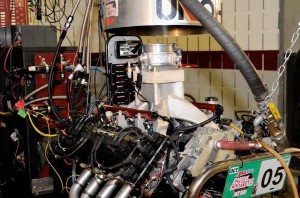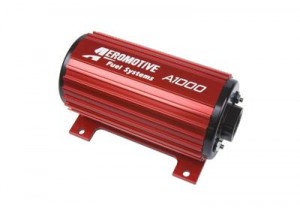“Which size fuel pump do I need?”
According to the Summit Racing technical department, it’s one of the most common questions they hear. It’s not about the physical size of fuel pump; rather, the question refers to the volume of fuel the pump can flow.
Many companies rate fuel pump size based on gallons-per-hour (GPH), liters-per-hour (LPH), or lbs./hr. of free flow. Companies like Aeromotive also simplify things a bit by including a real-world horsepower rating with their fuel pumps.
We reached out to the fuel system experts at Aeromotive and Summit Racing to determine what you need to know when choosing a high performance electric fuel pump for your application. They’ve identified three key factors you need to know when selecting a fuel pump.
How Much Fuel Do You Need?
We’re talking fuel volume here. And there are really two things that come into play when determining fuel volume: vehicle horsepower and BSFC (brake specific fuel consumption).
In order to make the proper calculation, you need to start by determining your vehicle’s maximum horsepower. You can determine this by having your vehicle dyno tested or by making a reasonable horsepower estimate based on the manufacturer’s advertised horsepower plus an estimate of power gains made by aftermarket modifications. If you are making an estimate of your horsepower, Aeromotive suggests that you err on the high side to be safe.
BSFC (brake specific fuel consumption) is a measurement of the amount of fuel consumed per unit of power produced. According to Aeromotive, a typical gasoline engine will use less than one pound of fuel to make one horsepower for one hour, so you should expect the BSFC number to be less than one. However, this number will vary for every application, depending on the specific engine combination, power adders, fuel type, octane ratings, and more.
For example, Aeromotive offers these guidelines for BSFC:
Gasoline: Baseline
- Naturally aspirated engines: 0.4 to 0.5 BSFC
- Nitrous combinations: 0.5 to 0.6 BSFC
- Forced induction engines: 0.6 to 0.75 BSFC
Ethanol: Plan for 30-35% more fuel consumption than gasoline burning engines.
- Naturally aspirated engines: 0.6 to 0.7 BSFC
- Nitrous combinations: 0.75 to 0.8 BSFC
- Forced induction engines: 0.85 to 0.95 BSFC
Methanol: Plan for 100-200% more fuel consumption than gasoline burning engines.
- Naturally aspirated engines: 0.9 to 1.1 BSFC
- Nitrous combinations: 1.2 to 1.3 BSFC
- Forced induction: 1.8 to 2.0 BFSC
Again, these are just general guidelines. The recommended method for establishing BSFC is through proper flywheel dyno testing. In contrast to your estimated horsepower rating, you should lean toward the low side on your BSFC if you are estimating.
Once you’ve determined your engine’s horsepower output and BSFC, you can determine your vehicle’s fuel requirements using the following equations:
Optimal lbs./hr = (Max. HP x BSFC)
Optimal GPH = (Max. HP x BSFC) / 6
Optimal LPH = (Max. HP x BSFC) / 1.585
Using 650 horsepower, let’s figure out the fuel requirement (volume) for a naturally aspirated gasoline engine:
Optimal lbs./hr: (650 HP x .4 BSFC) = 260 lbs./hr. of gasoline
Optimal GPH: (650 HP x .4 BSFC) / 6 = 43.3 GPH of gasoline
Optimal LPH: (Max. HP x BSFC) / 1.585 = 164 LPH of gasoline
Based on volume, this answers the original question: “What size fuel pump do I need?” According to Aeromotive, though, this is just the first step in selecting a fuel pump.
Base Fuel Pressure
Keep in mind, a certain amount of fuel pressure is always required to maintain engine performance by assuring that fuel is available on demand. For example, most naturally aspirated carbureted street engines generally require between 6 and 8 psi. Racing applications and EFI setups will require more base fuel pressure. The key is to establish what that base fuel pressure will be and if, as with forced induction or certain “dry nitrous” kits, pressure will be required to change with engine load.
How does changing fuel pressure affect pump delivery?
As fuel pressure increases, the volume will decrease with everything else being equal. So as engine demand goes up, as is often the case in forced induction applications, the amount of required fuel pressure will increase, causing the fuel volume to the engine to go down. Other factors and conditions, such as acceleration G-forces and friction within the fuel system itself, will also affect fuel pressure.
To illustrate this, we’ve taken one of the most popular and efficient EFI pumps on the market: the Aeromotive A-1000 fuel pump (part #11101). Let’s examine five different scenarios to demonstrate the effect various fuel pressures have on flow volume:
- Carbureted, Naturally Aspirated, 9psi base pressure and 13.5v,
HP capacity 1,862 FWHP @ .5 BSFC = 931 lbs./hr. volume
- EFI, Naturally Aspirated, 43psi base pressure and 13.5v,
HP capacity 1,588 FWHP @ .5 BSFC= 794 lbs/hr. volume
- EFI Blown with 20psi boost, 1:1 Regulator, 43psi base pressure, 63psi plus boost, and 13.5v,
HP Capacity 1,098 FWHP @ .65 BSFC = 714 lbs/hr. volume
- EFI Blown with 10psi boost, 4:1 FMU, 43psi base pressure, 83psi plus boost and 13.5v,
HP Capacity 975 FWHP @ .65 BSFC = 634 lbs/hr. volume
- EFI Blown with 6psi boost, 8:1 FMU, 43psi base pressure, 91psi plus boost and 13.5v,
HP Capacity 926 FWHP @ .65 BSFC = 602 lbs/hr. volume
With fuel pressures varying from 9 psi to 91 psi, flow volume is reduced a total of 35 percent. Comparing volume at 63 psi for a high boost kit with correct injectors to 91 psi for a low boost application, with small injectors and an FMU, volume is reduced by 16 percent.
Clearly rising fuel pressure has a notable impact on flow volume. What is not shown (and rarely published) is the devastating impact this has on less efficient, traditional pumping mechanisms used by much of the competition. It is obvious that eliminating unnecessary fuel pressure rise, e.g. removing an FMU and installing the correct injector, increases flow, maximizing the horsepower potential of any fuel system.
Voltage Supply
Often overlooked, voltage supply (as measured at the fuel pump terminals) is crucial to electric fuel pump performance. Voltage to an electric motor is like fuel pressure to an injector—more pressure in equals more volume out. Higher voltage at the pump terminals increases motor torque, resulting in more rpm and an increased flow volume for a given pressure.
Let’s go back and take a look at that Aeromotive A-1000 fuel pump. At 80 psi, this pump will see a 22 percent increase in volume when voltage is increased from 12 volts to 13.5 volts. This can make or break pump performance, especially at high pressures. The key here is to figure flow at voltage based on whether an alternator is used or not. Often deleted on drag cars, the lack of a correctly sized and properly functioning alternator is vital to consider when choosing a fuel pump.
Armed with this knowledge, you’ll be able to make an educated decision on which performance fuel pump is right for your vehicle.



[…] recommend you check out our earlier article that covered the basics of choosing a fuel pump. We took a closer look at fuel flow and pressure and how they relate to a particular engine. We […]
[…] earlier post discussing the differences between mechanical and electric fuel pumps and another on how to choose the right size fuel pump in terms of volume and […]